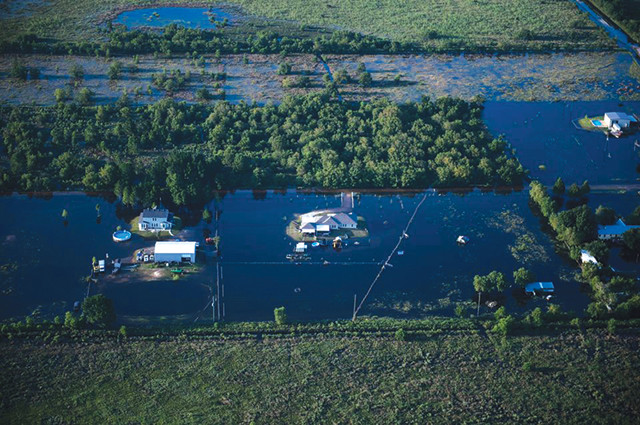
by Rachel Crowell Tuesday, July 3, 2018

Along the Gulf Coast — where Hurricane Harvey struck in 2017 — combining natural protections, like restored wetlands, with built infrastructure could prevent half or more of the flood damages expected to occur by 2030. Credit: U.S. Department of Agriculture/USAF Tech. Sgt. Larry Reid Jr.
As coastal development skyrockets and the effects of climate change escalate, flooding is becoming an increasingly common threat. A new statistical analysis of the costs and benefits of various coastal protection methods along the U.S. Gulf Coast suggests communities could prevent a significant amount of flood damage by implementing a combination of natural defenses and built infrastructure.
A cornucopia of possible protective measures exists, from restoring oyster reefs and other natural ecosystems that offer protection, to erecting human-made “gray” infrastructure — so named because they’re typically made from concrete — like seawalls, to enacting policy measures like limiting homebuilding to higher elevations.
By implementing cost-effective natural and gray infrastructure protections, sometimes called green-gray solutions, communities along the U.S. Gulf Coast could save between $57 billion and $176.6 billion in flood-related damages by 2030, according to a study recently published in PLOS ONE. (Measures were deemed cost-effective in the study if their calculated benefits outweighed their financial costs.) Those savings represent 42.8 to 57.2 percent of the total flooding damages expected to occur in the study area within the next 12 years.
Natural measures could contribute more than $50 billion to those potential savings, yet U.S. states and federal agencies currently spend the bulk of their pre-hazard mitigation and adaption funds on creating seawalls and other gray infrastructure, the study’s authors note. What’s more, this gray infrastructure “can further degrade coastal ecosystems,” increasing their vulnerability to future storms, the researchers wrote.
Natural, or “green,” solutions can perform similar functions to built infrastructure while restoring original habitat. For example, coral or oyster reefs and coastal vegetation such as mangroves, marshes, seagrass or kelp beds dampen waves and slow storms. Beaches, dunes and barrier islands, and sometimes large coastal marshes and mangrove forests, also act as physical barriers and partially mitigate storm surges.
“The same engineering models today used for coastal engineering can be used to study green measures,” says Borja Reguero, a coastal engineer at the University of California, Santa Cruz, and lead author of the study.
Reguero and his colleagues statistically analyzed the cost-effectiveness of different flood-reduction measures that could be utilized in coastal areas around the Gulf of Mexico.
Specifically, the team studied potential coastal impacts of 15,000 hypothetical future storms that were modeled after historical storms since 1851— each with slightly different locations, directions, paths and wind speeds from the original storms. From their models, the researchers calculated atmospheric pressures, wind speeds, rainfall, wind-generated waves, storm surges, expected amounts of flooding, and expected economic damage for each hypothetical storm.
They then analyzed the costs and benefits of proposed protective measures and determined ratios for the relative cost-effectiveness of different protective measures. For example, artificial beach nourishment intended to broaden coastal beaches along the Texas Gulf Coast resulted in a benefit-to-cost ratio of 0.28, while stacking sandbags around all houses in low-lying areas during all Category 3 hurricanes had a very high benefit-to-cost ratio of 10.
The team also calculated the overall potential damage reduction conveyed by each of the measures. For example, while the sandbag measure was the most cost-effective for the Texas coast, the total benefit it provided in the team’s calculations was small and fleeting. Conversely, “gray and policy measures such as local levees and elevation of homes could deliver the greatest damage reduction benefits for a single measure, but they are expensive to implement over large areas and are not cost-effective overall,” the researchers wrote.
The team found, however, that natural measures lie in an economic sweet spot: They are cost-effective while also providing robust overall risk reduction. For example, according to the researchers’ estimates, wetland restoration designed with risk reduction in mind has a higher benefit-to-cost (8.72) ratio than local levees (0.99), while also having a higher total overall benefit (18.2) than sandbags (8.4).
The PLOS ONE study “is going to be a game-changer,” sparking “changes in how people think about ecosystems” and highlighting how features such as oyster reefs and seagrass meadows can protect homes and businesses from destructive storms, says Curt Storlazzi, a geologist and oceanographer at the U.S. Geological Survey in Santa Cruz, Calif. Storlazzi wasn’t involved with the study, but he, Reguero and another researcher on the study are collaborating on a different study of coral reefs.
While the underlying modeling strategy and statistics of the study are sound, Storlazzi says, one drawback is its broadness. “When you go up to larger scales, you lose precision,” he says. However, in the future, he adds, communities can build on this large-scale study to design studies focused on maximizing flood protections at the local level.
© 2008-2021. All rights reserved. Any copying, redistribution or retransmission of any of the contents of this service without the expressed written permission of the American Geosciences Institute is expressly prohibited. Click here for all copyright requests.